네트워크 본딩(Network Bonding)을 해보고 실제 본딩된 slave 인터페이스를 끊어도 네트워크가 잘 되는지 확인해보자.
환경
- CentOS 7.7.1908
- Ubuntu 18.04
- VirtualBox
- Bash shell(/bin/bash)
기본 네트워크 구조

- NIC 2개를 본딩
- 호스트 전용 어댑터(Host-only Adapter)를 통해 각 VM의 2개의 NIC는 vboxnet0에 연결됨
- VirtualBox에서 설정-네트워크에서 어댑터1에는 기존 NAT를 연결
- VirtualBox에서 설정-네트워크에서 어댑터2와 어댑터3를 새로 연결
시나리오
- Client에서 Server에 Bonding된 IP주소로 Ping을 보낸다.
- Server의 active slave를 Down으로 만든다.
- 끊기지 않고 Ping이 계속 가는지 확인한다.
네트워크 본딩 설정
CentOS
centos-client
- bond0
- /etc/sysconfig/network-scripts/ifcfg-bond0
TYPE=Bond
BOOTPROTO=static
DEFROUTE=no
NAME=bond0
DEVICE=bond0
ONBOOT=yes
PREFIX=24
IPADDR=192.168.99.101
BONDING_OPTS="mode=1 miimon=100 fail_over_mac=1"
- enp0s8
- /etc/sysconfig/network-scripts/ifcfg-enp0s8
NAME=enp0s8
DEVICE=enp0s8
TYPE=Ethernet
BOOTPROTO=none
ONBOOT=yes
MASTER=bond0
SLAVE=yes
- enp0s9
- /etc/sysconfig/network-scripts/ifcfg-enp0s9
NAME=enp0s9
DEVICE=enp0s9
TYPE=Ethernet
BOOTPROTO=none
ONBOOT=yes
MASTER=bond0
SLAVE=yes
centos-server
- bond0
- /etc/sysconfig/network-scripts/ifcfg-bond0
TYPE=Bond
BOOTPROTO=static
DEFROUTE=no
NAME=bond0
DEVICE=bond0
ONBOOT=yes
PREFIX=24
IPADDR=192.168.99.102
BONDING_OPTS="mode=1 miimon=100 fail_over_mac=1"
- enp0s8
- /etc/sysconfig/network-scripts/ifcfg-enp0s9
NAME=enp0s8
DEVICE=enp0s8
TYPE=Ethernet
BOOTPROTO=none
ONBOOT=yes
MASTER=bond0
SLAVE=yes
- enp0s9
- /etc/sysconfig/network-scripts/ifcfg-enp0s9
NAME=enp0s9
DEVICE=enp0s9
TYPE=Ethernet
BOOTPROTO=none
ONBOOT=yes
MASTER=bond0
SLAVE=yes
Ubuntu
- 18.04는 netplan을 이용해 네트워크를 세팅한다.
- yaml 파일을 만들고
sudo netplan apply를 통해서 네트워크 설정들을 적용
ubuntu-client
- /etc/netplan/50-cloud-init.yaml
# This file is generated from information provided by
# the datasource. Changes to it will not persist across an instance.
# To disable cloud-init's network configuration capabilities, write a file
# /etc/cloud/cloud.cfg.d/99-disable-network-config.cfg with the following:
# network: {config: disabled}
network:
ethernets:
enp0s3:
dhcp4: true
enp0s8:
dhcp4: false
enp0s9:
dhcp4: false
version: 2
bonds:
bond0:
dhcp4: false
addresses:
- 192.168.225.101/24
gateway4: 192.168.225.1
interfaces:
- enp0s8
- enp0s9
parameters:
mode: active-backup
primary: enp0s8
fail-over-mac-policy: active
mii-monitor-interval: 100
ubuntu-server
- /etc/netplan/50-cloud-init.yaml
# This file is generated from information provided by
# the datasource. Changes to it will not persist across an instance.
# To disable cloud-init's network configuration capabilities, write a file
# /etc/cloud/cloud.cfg.d/99-disable-network-config.cfg with the following:
# network: {config: disabled}
network:
ethernets:
enp0s3:
dhcp4: true
enp0s8:
dhcp4: false
enp0s9:
dhcp4: false
version: 2
bonds:
bond0:
dhcp4: false
addresses:
- 192.168.225.102/24
gateway4: 192.168.225.1
interfaces:
- enp0s8
- enp0s9
parameters:
mode: active-backup
primary: enp0s8
fail-over-mac-policy: active
mii-monitor-interval: 100
테스트
각각 active slave 확인
- 명령어:
cat /proc/net/bonding/bond0 - 왼쪽이 Client 오른쪽이 Server
- Active slave: enp0s8
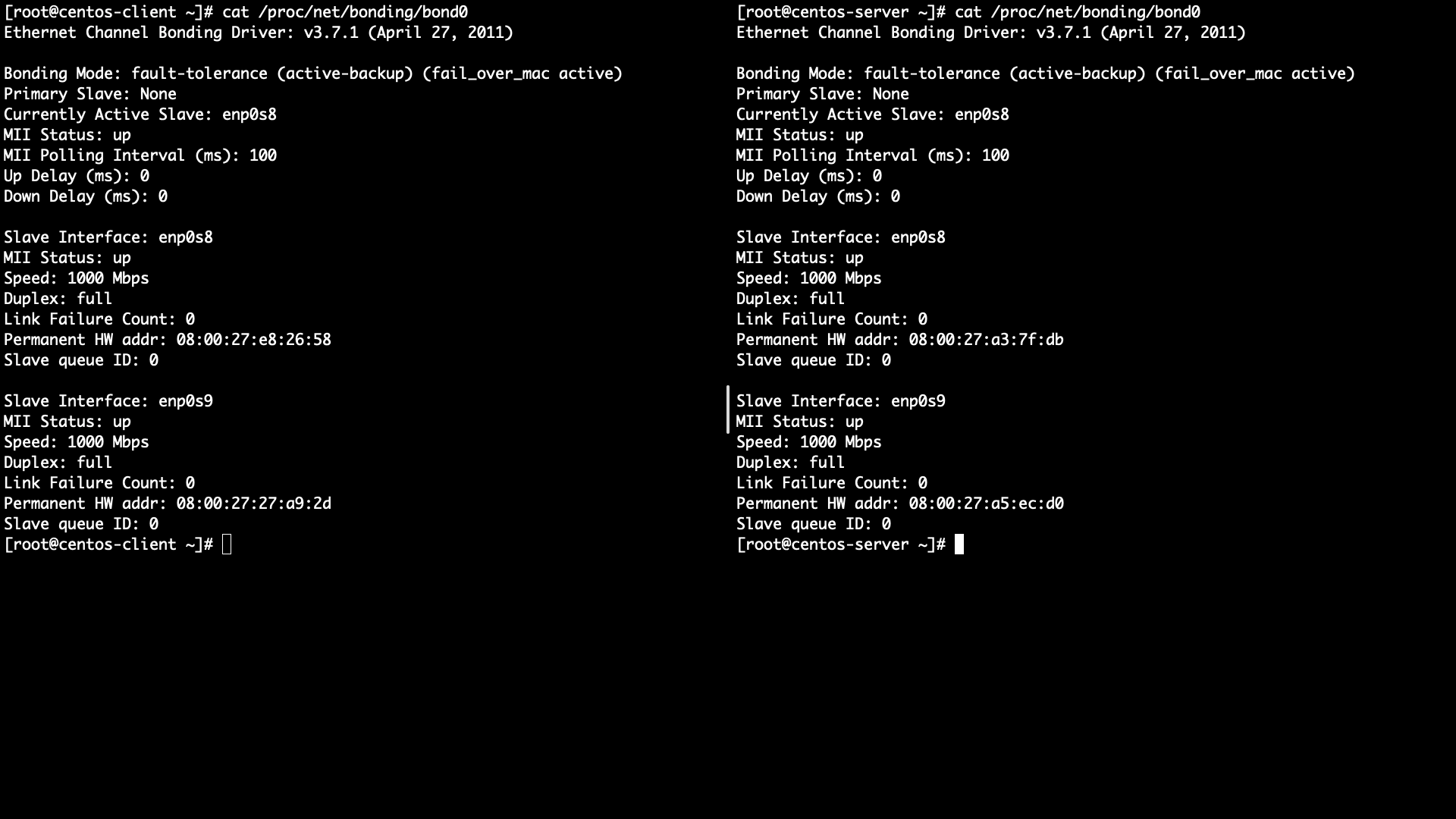
Client -> Server ping 시작
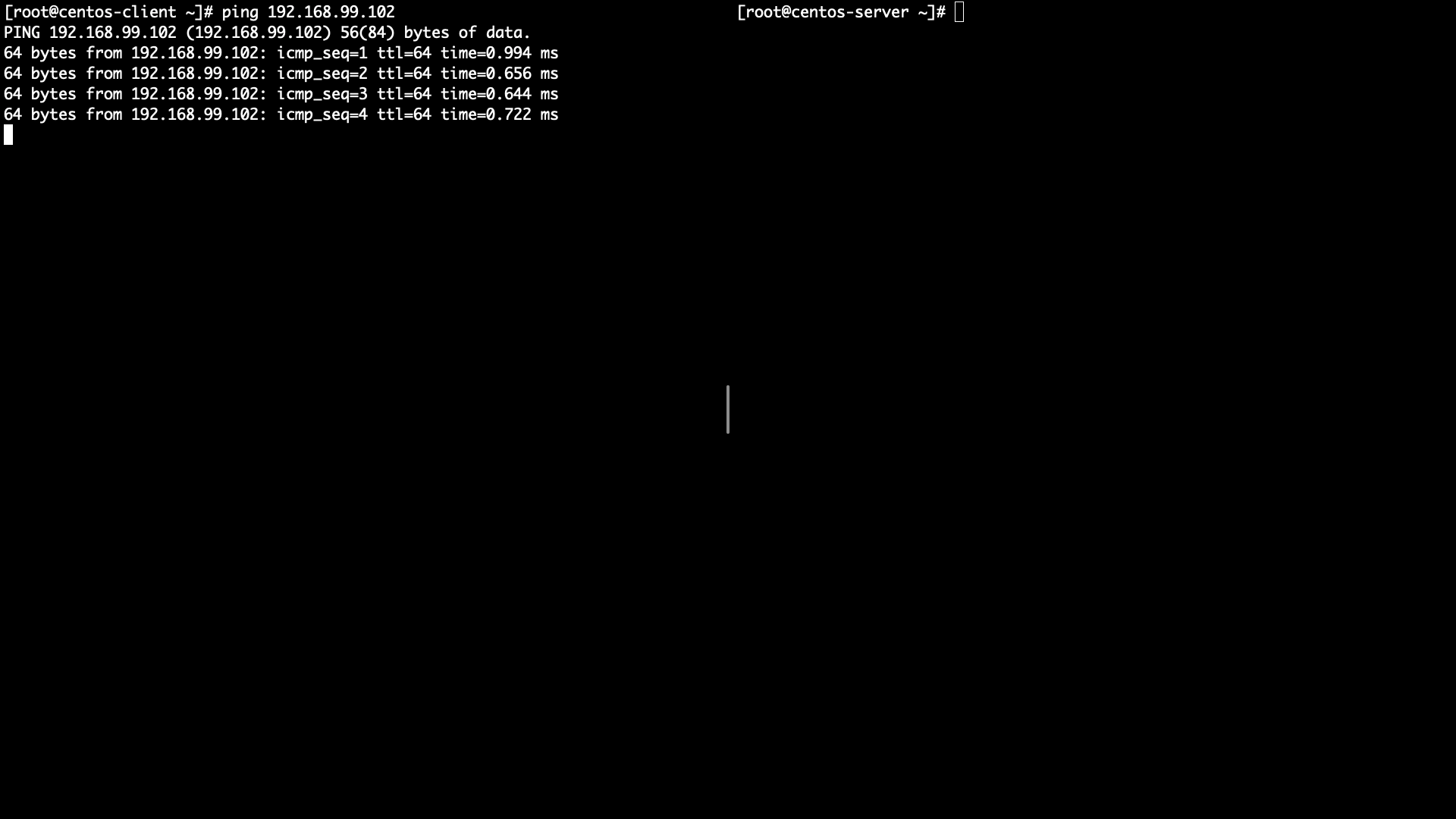
Server active slave link down
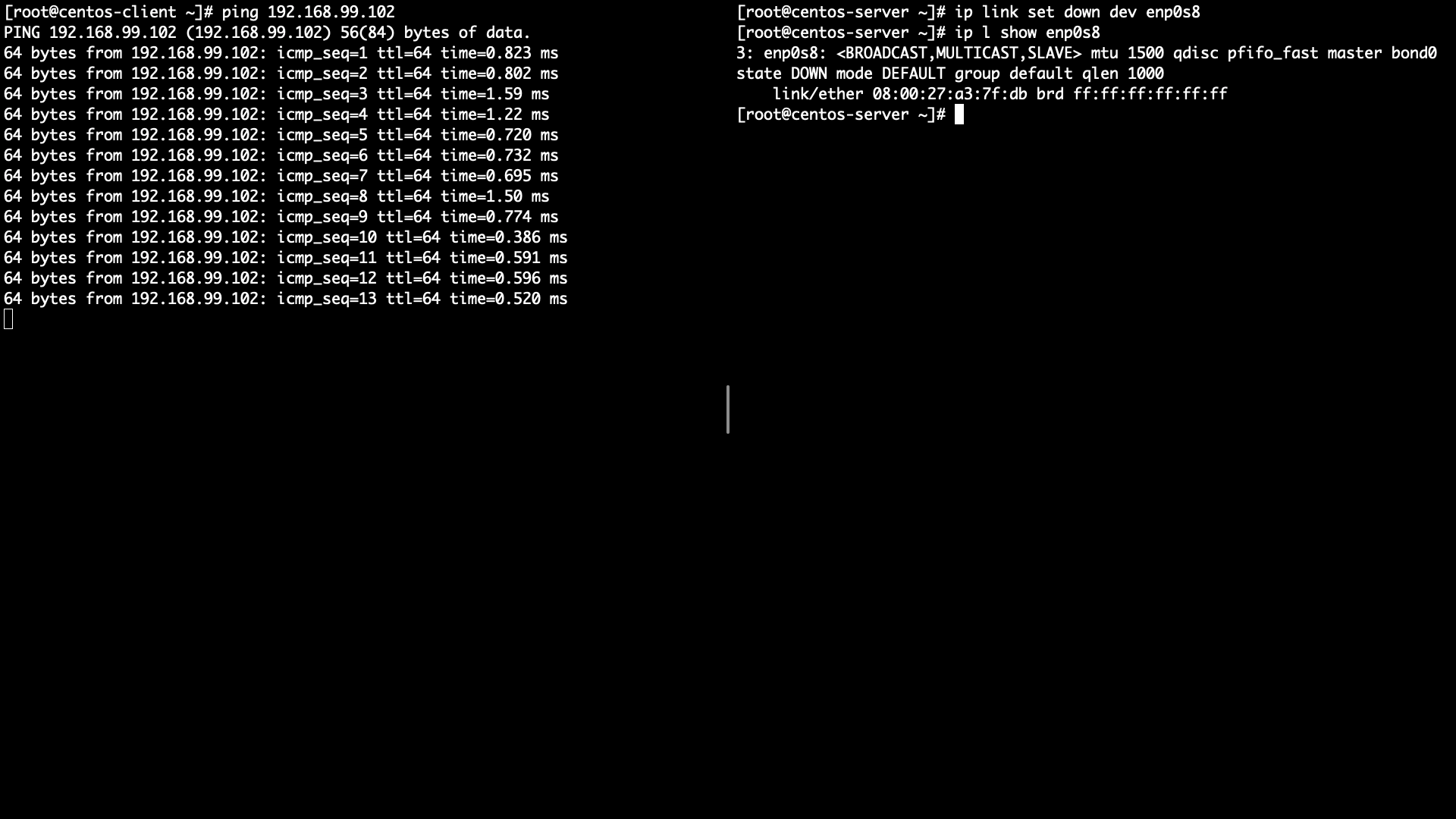
Ping이 끊기지 않고 제대로 가는지 확인
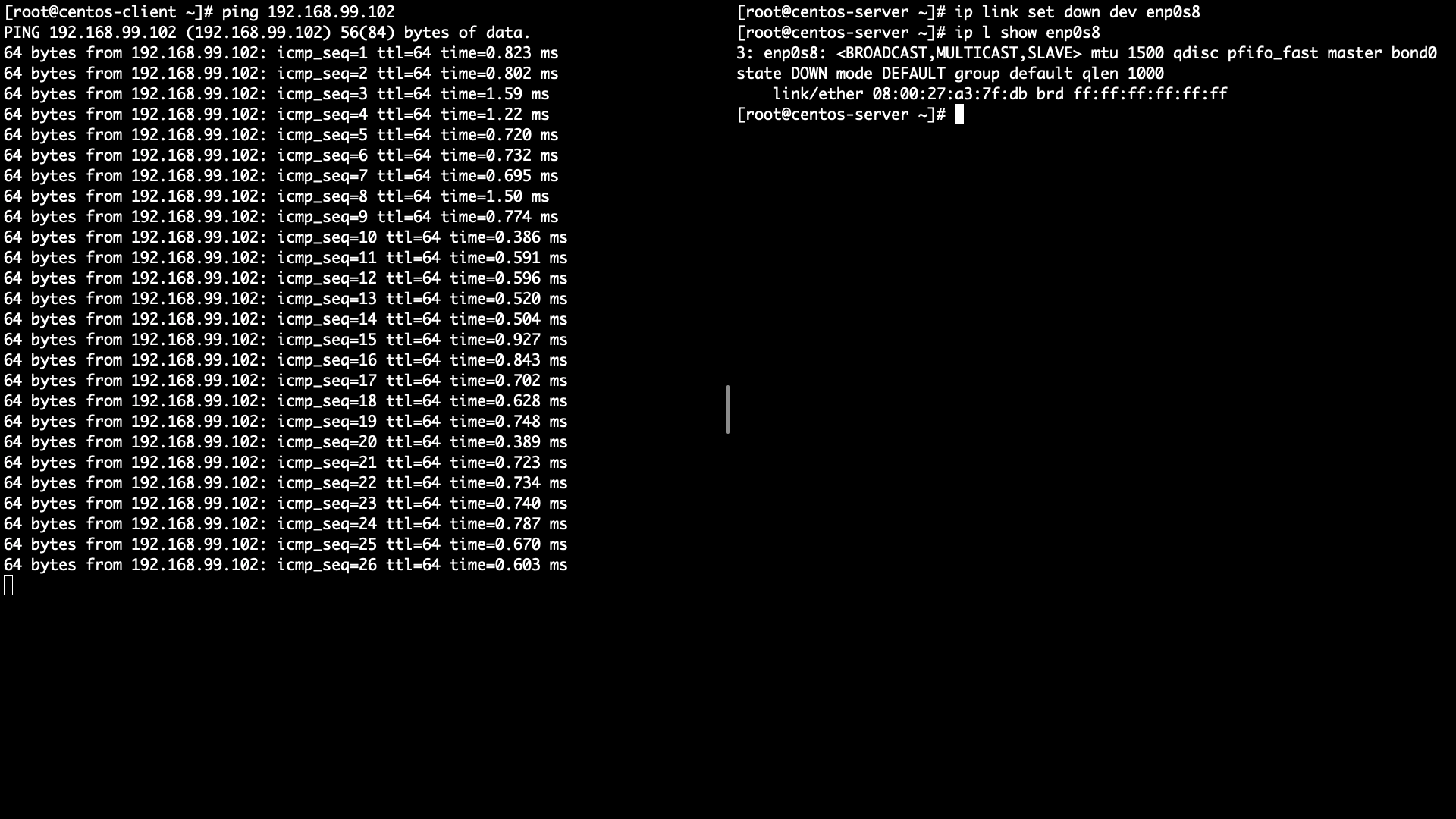
Server에서 active slave가 누군지 확인
- enp0s8 -> enp0s9
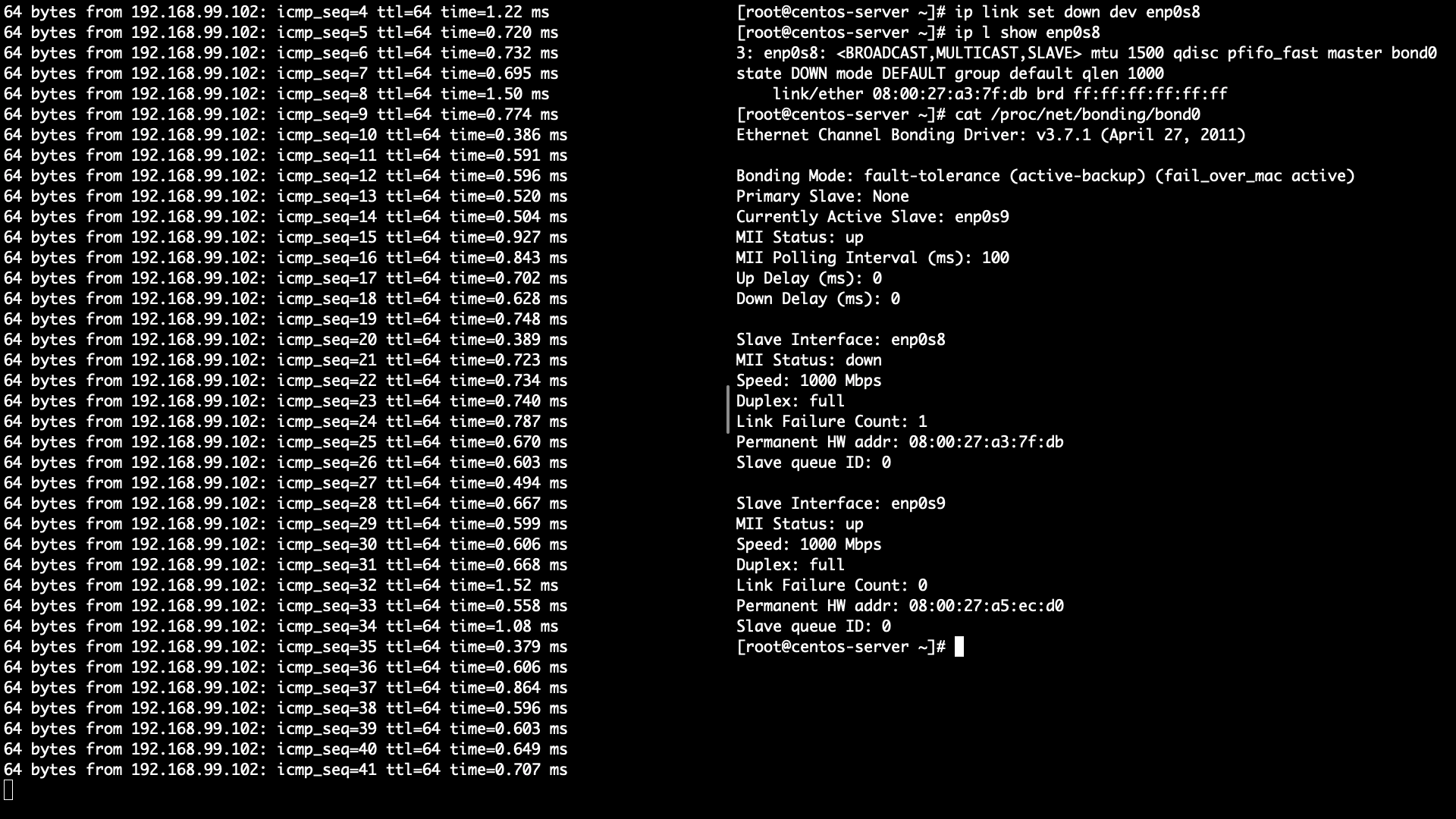
참고자료
- https://www.interserver.net/tips/kb/network-bonding-types-network-bonding/
- https://askubuntu.com/questions/1033531/how-can-i-create-a-bond-interface-in-ubuntu-18-04
- https://www.snel.com/support/how-to-set-up-lacp-bonding-on-ubuntu-18-04-with-netplan/
- https://netplan.io/examples
- https://netplan.io/reference

